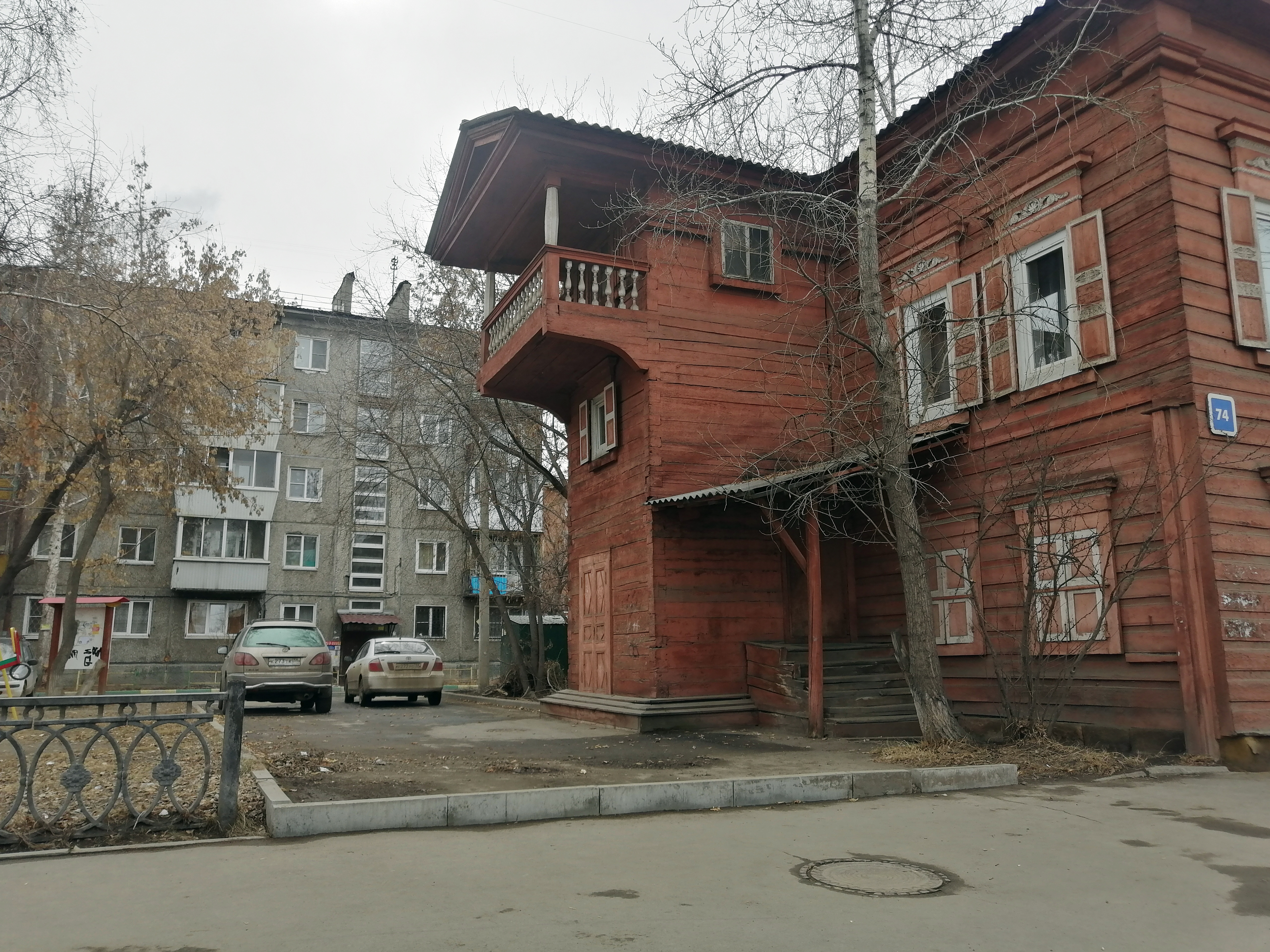Spatial transformation processes will be documented using the example of selected residential districts from different eras in Nizhneudinsk, Irkutsk, Tula, and Chelyabinsk. In addition to analysing urban-spatial and architectural-design changes, the transformation of usage options and social structures will be explored. The research methods will include a systematic, criteria-based search for examples by means of evaluating primary and secondary literature, site visits, and expert and resident surveys.
Lead: Prof. Barbara Engel (urban development and planning, Karlsruhe Institute of Technology), together with Dr. Anastasia Malko, Ekaterina Gladkova M.A. and Marina Sapunova M.A. (all Karlsruhe Insitute of Technology).
Investigation and evaluation of representative spatial transformation processes in selected residential neighbourhoods of the late 19th and 20th centuries in Nizneudinsk, Irkutsk, Tula and Chelyabinsk.
Within the research project should be evaluated, what architectural, functional and social transformations of the existing housing stock are recognizable. Patterns of the different housing districts will be identified. Aim of the project is the categorization of the treatment of housing stock and approaches to valorization? How are the approaches received among planners and heritage conservationists as well as by the public? What are ‘good practices’ in preservationist urban development? What strategies, methods and instruments have been used for this purpose? Based on the analysis, of the transformations conclusions for knowledge transfer between regions, cities, towns and neighbourhoods will be drawn.
First phase of the project will consist of baseline assessment and preparation of the urban planning analyses, such as evaluation of international literature and adaptation of good practice planning. Based on this research the analysis matrix for the urban planning analyses. The first phase of work will conclude with a joint meeting of the Research Network in Leipzig to reflect on the knowledge acquired and to review and update the research design.
This phase is followed by the the analysis of structural, functional and social transformations in selected cities, Tula, Chelyabinsk, Irkutsk and Nizhneudinsk. Selected neighbourhoods will be photographed and drawn, and the urban-spatial and functional changes that have taken place will be described verbally and graphically. Interviews and focus group discussions will be held, including with people in leading positions in city administrations, housing companies and associations, and property management firms, as well as with local architects and citizens. Part of the respective analysis phases will comprise expert workshops in the form of local round tables, where the interim findings will be presented and discussed with experts from research as well as representatives of administrations and politics, the private sector, and civil society initiative groups in the context of current social conditions and expectations as well as functional requirements and applicable planning laws. The results will be published in specialist articles.
Final phase is the evaluation, with verbal and graphic assessment of the findings as well as the drafting of conclusions and recommendations. The materials produced will be conclusively systematized, edited, and prepared for publication in a book.
The built residential environment represents the built heritage, carrying historical memory and spatial values of a particular era. In post-Soviet Russia, the historic building stock is constantly threatened by deformation and demolition, especially when discussing residential districts' urban structures and housing estates. As part of memory and of the accumulated experience of the spatial organization of the environment, it is crucial to understand the nature and distinctive character of residential morphotypes of previous eras. The more we are aware, the more accurate an approach to dealing with the urban structure is a chance to develop.

@ Ekaterina Gladkova
In Russia's represented research time frame from the end of the 19th century to the 20th century, there are two contrary periods: before the Revolution (1917) – Imperial Period and the Soviet Era 1917–1991. In addition to radical socio-economic transformations, these two periods also significantly influenced ideas about the development of the living environment and planning structure. Thus, both eras are characterized by fundamental differences in urban planning policy, property relations and the economic structure and, at the same time, rapid urban planning activity. In the pre-Soviet era, private non-state ownership prevailed. The Soviet-era is characterized by state ownership and directive governance. Each of them has main building phases and represents specific types of residential housing that reflect the history through the evolution of residential development in Russia.
While we are talking about radical changes in the pre-Soviet and Soviet periods, each is heterogeneous. Socio-economic, political changes and professional discussion stimulated the evolution of ideas and ideas about the living environment and formed housing and spatial policy tasks. Approaching the topic of the spatial residential environment values had systematized the knowledge about the evolution of housing morphotypes and traced the change of ideas in four dominant morphotypes during the 19th-20th century in Russia: Urban Block, Garden City, Socialist City and Microrayon.
Case studies were chosen based on the following arguments:
- volume of housing of a particular morphotype, which is represented by a large number of buildings and districts and gives the possibility to observe transformations;
- high architectural and cultural value of a morphotype for Russian cities' architectural and planning history. The consideration of this morphotype is crucial during the process of city reconstruction and urban renewal and should be considered in order to provide a sustainable approach to the development of Russian cities;
- grade of transformation: residential morphotype that has an ongoing active process: changes and transformation of existing urban residential structures. Different types and grad of transformation by planned and unplanned changes (from state programs to the pressure of investors). Partly those processes lead to the threat of losing the architectural morphotype important for history.
Based on these criteria, several cities in Russia had been taken as case studies: Chelyabinsk, Tula, Irkutsk and Nizhneudinsk.

Pic. 02 cases selection scheme by M. Sapunova
These cities represent different geographical regions: Tula in central Russia, Chelyabinsk in the Urals, and Irkutsk and Nizhneudinsk in Eastern Siberia. Nowadays, Irkutsk and Chelyabinsk are on the list of cities mentioned as prospective centers of economic growth. Tula is in the list of Cities and adjacent municipalities with a total population of more than 500 thousand people, forming major urban agglomerations and major urban agglomerations (Source: SRP (National Spatial Strategy of Russia, p. 106) that as well support the dynamic development of the city and effects existing residential morphotypes. The selected cities represent different categories of cities depending on population size: million-strong Chelyabinsk, large cities Irkutsk and Tula with a population of about 620 and 470 thousand people and small city Nizhneudinsk with a population of about 34 thousand people. The size of the city is essential, as it entirely affects the types and pace of transformation of residential neighborhood development. The presence of different cities in terms of size allows us to identify the most significant pressure on the existing morphotypes typical for central areas of large cities, at the same time to trace in a comparison possible authentically preserved morphotypes of residential development in small towns that contributes to the development of strategies for sustainable development of these neighborhoods.
2025
Sapunova, M., Gladkova, E., Malko, A., & Engel, B. (2025). Living in Soviet housing estates: Urban space, transformations, and residents’ narratives. Europe-Asia Studies, Soviet Housing Heritage: Urban and Social Development in Socialist-Era Residential Areas (Special Issue, upcoming).
Gundarina, P., & Sapunova, M. (2025). Beyond the narrative of the ‘Wild 1990s’: The societal and spatial transformation of former Soviet houses of culture. In M. Babić & T. Mager (Eds.), Contentious Spaces of State Socialism. Leuven University Press (forthcoming).
2024
Engel, B. (2024). Echoes of Soviet urbanism: Exploring modernist housing narratives. DOM Publishers. https://dom-publishers.com/products/echoes-of-soviet-urbanism
Engel, B., & Rogge, N. (2023). Large housing estates under socialism: Experiences and perspectives on sustainable development of mass housing districts. Transcript Publishing. https://www.transcript-verlag.de/978-3-8376-6782-0/large-housing-estates-under-socialism/?c=310000010
Malko, A., & Kozlova, L. (2024). Universitetskiy, Irkutsk, Russia: Identification of the value in the functional balance. In Echoes of Soviet urbanism: Exploring modernist housing narratives (pp. 172–189). DOM Publishers.
Malko, A., Lytvynenko, M., Bakyn, A., & Baratvakili, I. (2024). Analyzing sidewalk accessibility for people with disabilities: A case study of Lviv, Ukraine. Regional Problems of Architecture and Urban Planning, December, 6–21.
Malko, A., Kozlova, L., & Kozlov, V. (2024). Irkutsk Akademgorodok district—Principles for the development of spatial qualities. In B. Engel & N. Rogge (Eds.), Large Housing under Socialism: Experiences and Perspectives on Sustainable Development of Mass Housing Districts (pp. 263–280). Transcript Verlag.
Sapunova, M., & Gladkova, E. (2024). Unravelling inherited residential patchwork of Purvciems Microrayon in Riga, Latvia. In Echoes of Soviet urbanism: Exploring modernist housing narratives (pp. 124–139). DOM Publishers.
Sapunova, M. (2024). When property relations face the built legacy of socialism. In S. van Dyk, M. Kip, F. Peters, & J. von Puttkamer (Eds.), Urban property conflicts in Europe, East and West: A blog series on local struggles for self-governance. https://sfb294-eigentum.de/en/blog/when-property-relations-face-the-built-legacy-of-socialism/
2023
Engel, B., Malko, A., & Baratkavili, I. (Eds.). (2023). Metropol.x Lviv: Urban planning in a global context.Karlsruhe Institute of Technology, Institute for Urban and Landscape Design (IESL), Chair of International Urban Planning and Design (ISTB).
Engel, B. (2023). Herausforderungen in deutschen Großsiedlungen. Reflexion. Strategien für die Weiterentwicklung von Großsiedlungen (Workshop, Kompetenzzentrum Großsiedlungen e.V.), Berlin, 06.–07. Juli.
Malko, A., Besedina, A., Kravchenko, I., Romanova, M., & Baratvakili, I. (2023). Evaluation of spatial transformations in the center of Lviv on the example of Svobody avenue. Regional Problems of Architecture and Urban Planning, (17), 41–56.
Sapunova, M., & Borushkina, S. (2023). Utilitarian heritage: Questioning current debate on socialist mass housing in Moldova, Armenia, and Uzbekistan. Docomomo Journal, 68, 46–54. https://doi.org/10.52200/docomomo.68.05
2022
Engel, B. (2022). The concept of the socialist city: Plans and patterns of Soviet urbanism. In C. Hein (Ed.), International Planning History Society Proceedings, 19th IPHS Conference, City-Space-Transformation (pp. 663–678). TU Delft Open. https://doi.org/10.7480/iphs.2022.1.6516
Malko, A. (2022). The urban planning protection of the monuments in Germany on the example of the Innere Neustadt district in the city of Dresden. Regional Problems of Architecture and Urban Planning, (16), 48–59.
Malko, A., Gladkova, E., Kozlova, L., & Tumureeva, M. (2022). Living lab in Irkutsk. Project Baikal, 70, 66–72. https://projectbaikal.com/index.php/pb/article/view/2080
Malko, A. (2022). The German experience of urban regeneration, taking the Blasewitz-Striesen Nord-Ost district (Dresden) as an example, and the possibility of its application in historical cities in Russia. In C. Hein (Ed.), International Planning History Society Proceedings, 19th IPHS Conference, City-Space-Transformation (pp. 769–784). TU Delft Open. https://doi.org/10.7480/iphs.2022.1.6439









